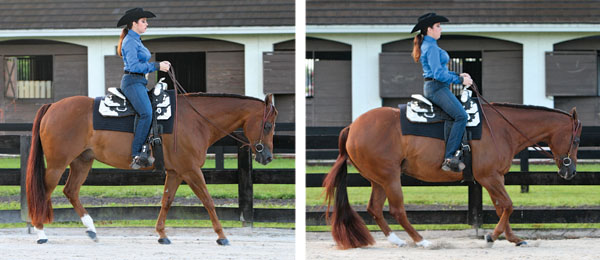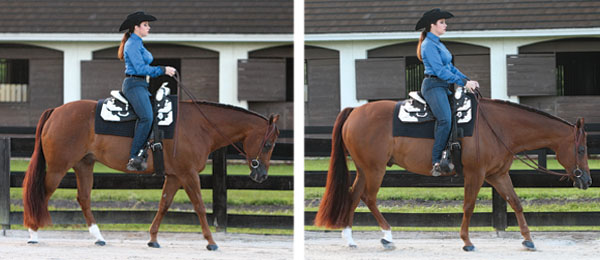Q I show a 9-year-old gelding in Western show classes. He carries his head very low, often below his withers. I can bump his face upward with my reins to get his head to elevate, but I have to do that every few strides, which isn’t appealing when being judged. What can I do at home to retrain him to not drop his head so low?

Avery Stiehl, New Hampshire
A From what you’ve described, it sounds like your horse is too tipped-forward—he’s heavy on his forehand, and therefore carries his head very low. You need to retrain him to drive forward from his hindquarters rather than pull with his front legs. To do this correctly, he’ll have to raise his head carriage, as well as use his back. This’ll improve his travel immensely; however, I’ll warn you: This can be a tedious process. But it’s well worth it for your horse to travel correctly.
The Tack
I suggest working him in a snaffle that he responds to well. The snaffle will allow you to maintain contact with your horse’s mouth to capture his face without being too harsh on his mouth or scaring him with a big bridle. You’ll need to ride two-handed for even control on each side so you can collect your horse’s body and encourage him to use his back and hindquarters as he travels.
Try this Bob Avila Collection Snaffle Bit by Professional’s Choice, paired with these Teskey’s Weighted Heavy Oil Split Reins for great control.
(As an Amazon Associate, we earn from qualifying purchases made through affiliate links.)
The Process
It’s easier and quicker to see results if you perform this exercise on circles of various sizes than on straight lines. Changing the size of the circle keeps your horse’s mind engaged and listening to your cues rather than focusing on fighting your efforts to drive him from behind. These photos are shown in profile on a straight line so you can better see what the horse and rider are doing.

Work at a trot—not a slow jog—and keep close contact on your horse’s mouth with your reins. Drive him forward into the bridle with your legs, kicking in rhythm with his gait. This’ll help him maintain pace, and that more forward gait will force him to use his hindquarters. If he’s lazily jogging along, he doesn’t have to use his body to get anywhere. That’s what he’s gotten away with to reach this point.
If the horse doesn’t respond to your cues to collect himself and drive from behind, stop him and hustle him back a few steps. This puts his weight on his hind end. Then trot him forward and try again. It’s important not to lose your patience. You’ll likely perform this drill over and over again before you see real, lasting results.
The Reward
When your horse collects himself and you can feel him driving from behind, lower your hands and see what he does. If he maintains an acceptable head position and self-carriage, stop him and praise him. Only go a few strides and stop before he has the chance to drop his head, hollow his back, and start pulling from the front again.

Patty Vatterott, Wellington, Florida, is a lifelong horsewoman who now focuses on coaching and educating amateur and youth riders to success in all-around events. Learn more at searidgefarms.com.






